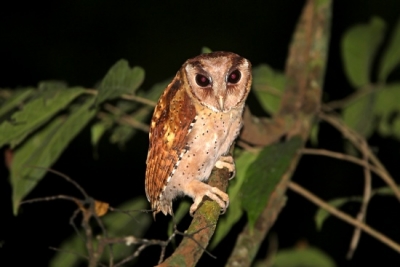
The Sri Lanka Bay Owl, or Phodilus assimilis, is a small-sized bay owl which belongs to the family Tytonidae. It is a rare and secretive bird that is seldom seen and only found in Sri Lanka and the Western Ghats region in Kerala – South India. It prefers tropical, moist forests and tropical high-altitude grasslands.
It is a distinctive looking bird with a heart-shaped face, brown, speckled upperparts and lighter underparts. Its facial disk is v-shaped in the middle with black, vertical streaks that pass downward through their intense black eyes. Its tail has 8 to 10 narrow dark bands and it has a yellowish beak. Its legs are short and feathered to the base of the bare toes, which are coloured a grayish-brown.
Also called the Ceylon bay owl, this evasive bird roosts in the hollows of trees during the day. It also makes its nest in tree hollows and lays around 2 to 3 pure white eggs. Incubation takes around 30 days, during which time the male owl will feed the female. Once the owlets hatch both parents assume duties of feeding and caring for them.
It has been observed that the young in a nest are often different in size which indicates that the eggs are laid over a period of several days. This owl has a pleasant, melodic whistling call which is repeated with inflections at a stretch.
Although there is always the threat of habitat loss, these owls are listed under ‘Least Concern’ in the IUCN Red List as they have a large range.
Picture Credit : Google
